|
Every special interest organization
has had the equivalent of a "Junior Problem" as reported in this 1968 issue of
American Aircraft Modeler magazine. It refers to efforts required to
attract younger participants - pre-teen and teenagers - into a particular
activity, and then how to keep them interested once involved. A common scenario
is where a kid becomes interested in model airplanes, boats, cars, etc., and
sometimes becomes very involved - even to the point of competition - and then
abandons the realm once he enters college, goes off to work, raises a family, or
is distracted by more important priorities. Often, though, once the critical
responsibilities lessen, he returns to his former interest, this time with more
knowledge and money to more fully enjoy the hobby. Personally, I have retained
my interest in all things aeronautical and astronautical throughout my six-plus
decades. At times that involved only reading and maybe building a scale plastic
model or attempting to introduce my kids to the fine art of building and flying
(unsuccessfully, BTW).
Proved by six years of solid results this co-curricular school
club program supplies many missing answers.
 Harold W. Warner Harold W. Warner
photography/The Author
How many times have you seen the words "junior-problem"? A hundred times? A thousand?
Well, if you're ready to admit that they just don't make kids like they used to,
buddy, you have plenty of company. I feel that the kids do pretty well for themselves
considering what today's society thrusts upon them. Want to make a modeler of every
kid on your block? If you're enthused with a missionary zeal, let me make a few
suggestions.
Six years ago, as a new teacher in an urban junior high school of about 1,700
prospective modelers, I founded the Sepulveda Balsa Butchers. Since I had not built
models for ten years, I went to a local hobby dealer for advice on how to get things
rolling, and he spent several hours discussing the subject, and even came to our
first meeting to give an informal talk on what makes things fly. Since that time,
I have found almost every hobby dealer in the area to be a gold-mine of ideas. Material
help such as discounts for blub members and prizes for contests is also invaluable
to a new club. Without their help, I might have become quite discouraged the first
semester.
Having put an announcement of the first meeting in the school bulletin, I eagerly
awaited the hundreds of boys which would surely be overjoyed to become a part of
an activity as utterly fascinating as aeromodeling When only abou30 showed up, I
was disillusioned to say the least. Undaunted, however, we embarked upon a building
program which was designed to arouse interest in all concerned. About half of the
original group survived until the end of the semester. Today, we average 40-50 members
each semester. Since then, we have tried many things - some resounding successes,
some dismal failures, but still the blub survives. A few of our ex-members are pilots
today. One took seven trophies at the Dallas Nats, and many drop in to see me on
their way to serve their country in various ways. I think the fight is worth it.
After six years of struggle, I'd like to suggest a few courses of action which
may be of use to the up-and-coming junior club. Please keep in mind that being a
co-curricular club in a public school, opens up certain areas, but restricts others.
A private club might well avail itself of handy facilities of the local school such
as gym, handicraft shop, or football field.
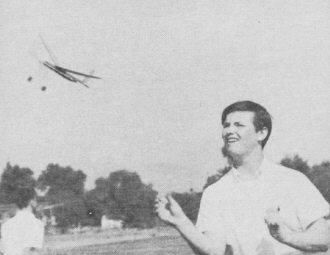
Good performance, up to two-minute flights, by an ROG will sustain
a youngster's interest.
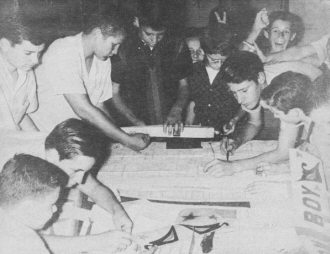
Built-up and tissue-covered models demand more skill; group discussion
to solve problems.
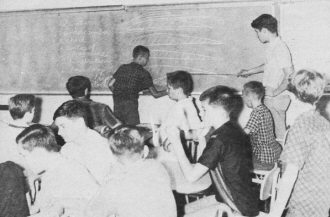
Classroom talks on theory, though necessary, are brief. Students'
attention-span is short.
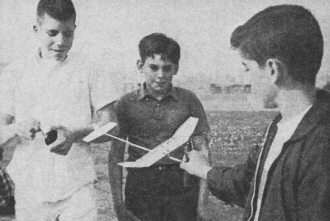
A first, original design effort benefits from quality wood and
rubber. A winder is a must.

Much can be done to make a basic, sheet-balsa glider perform.
Flight trimming starts here.
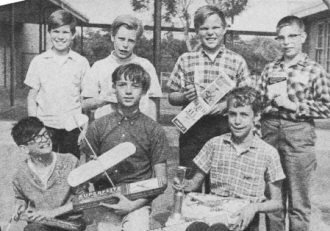
Monthly contest winners receive points. Total for year determines
who gets perpetual trophy.
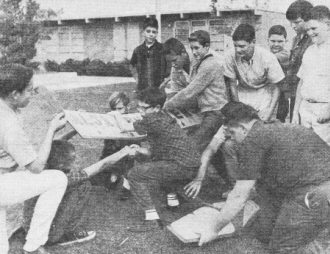
Larger models are a joint effort by the club members. Ramrod
1000 was the Butchers' first.
First and foremost, keep in mind the psychology of the pre-adolescent. In general,
he has a short attention span unless the activity is fiercely interesting. He is
used to more of the "good things" of life than you or I were, and may look down
on modeling as "kid stuff." you and I know that the public thinks model airplanes
are for six- and seven-year-olds, so how do you convince a very status-conscious
youngster that he will not be laughed at? Also the number of pursuits open to today's
youngsters is, to say the least, staggering. At our school alone there are 26 clubs
ranging from ham radio to chess clubs. An after-school activity has to compete with
Scouts, dances, paper routes, and just about triple the amount of homework you and
I took home. Many of my 11-13-year-olds have horses, mini-bikes, Little Leagues,
music lessons, color TV's and swimming pools to occupy their time. Clearly, the
prospective sponsor must realize all of these factors which are going to deter the
kids from a model club. However, there is another facet to the modern child which
was there when we were young, too, and that is an innate curiosity - a desire to
explore, to investigate. There is also a desire to create, and to create something
worthy of praise from his peers, his parents, the people he respects. This is the
key.
One of the first things a new club might want to do is build its image. Having
an experienced modeler or two put on a demonstration, gives modeling a little prestige.
Our club membership doubled after practically the entire student body watched one
of our hand-launched gliders soar daintily up and out of sight in an early-morning
thermal before school one day. A U-control stunt exhibition will bring spectators
from chess club, after-school football, and just about anywhere within earshot.
A display of well-built model aircraft along with some that are easily within the
capabilities of a junior modeler provides prestige from the more difficult ships,
but a goal to attain or exceed with the less-perfect craft.
One or two building sessions a week is a must, with expert guidance always at
hand. Members of local model clubs are more than happy to lend a hand in a beginners'
program. A small initiation fee, dues, and auctions of donated models and supplies
can build the club's supply-chest.
What will you need?
For a club of 30, I would suggest the following: one doz. X-acto knives, inexpensive
variety; 1 razor-blade plane with several replacement double-edged blades; 75 sheets
of assorted sandpaper, mainly coarse, cut into quarters; 1 roll transparent waxed
paper; 1 pint model cement and several small plastic squeeze bottles; 1 large box
of dressmakers' pins; 50 scrap-wood blocks of various sizes to use as sanding-blocks,
dihedral props, etc.
Sixteen to 24 building boards (local lumber yard will saw 8 from sheet of soft
fiber wallboard); 1 gallon nitrate-type airplane dope; 1 gallon pyroxylin nitrate
thinner; 5-6 oz. plasticiser for dope. TCP, castor oil, or "warp-resistor"; 1 doz.
3/4" artists' brushes (inexpensive variety).
There are many items which one might add to the list, but I have found the above
to be rather indispensable. If the club is to build just kit models, fine, but I
have found many good hand-launched gliders, rubber jobs, and other models in magazines
just waiting to be gobbled up by cost and quality-conscious juniors. A little tracing
and a ditto machine will make copies of good plans available to all club members,
and kits for these planes can be put together by club members in cooperation with
a local hobby dealer much more cheaply than one might imagine. Commercial kits are
handy, but often are atrociously priced, poorly designed, and filled with balsa
unsuitable for anything but axe handles or doorsteps.
A good sequence of beginners' projects might look something like this:
1) Small Vee-dihedral hand-launched glider 7"-12" span of good 8-12 lb. grain
contest balsa. (Light wood is a must. Cuts, sands easier and results in a lighter,
more forgiving plane.)
2) Polyhedral contest hand-launched glider such as the "Omega" or "Sweepette"
type; 3/16 to 1/4 light C-grain balsa wing, spruce fuselage, 1/16 or 1/32 sheet
C-grain stab.
3) All-sheet rubber ROG type plane, 12"-16" span made of 1/32" sheet, with plastic
propeller of Sleek Streek variety. Good rubber such as Pirelli 5/32 and a winder
a must for interest-sustaining performance of one to two minute flights. (All-sheet
gas models can be used at this time also.)
4) Built-up stick-and-tissue model either rubber, gas, or gravity powered. A
towline glider is a good idea since it avoids the added hassle involved with building
a good nose block or fiddling with an engine.
5) Advanced models adapted to abilities and interests of members. It is a good
idea to keep a small stock of graded kits on hand for modelers who are ready to
"move up."
I have found that a successful building program starts with a short talk and
demonstration on what we are going to be doing, has one or two completed or partially
completed models on hand for reference, and a great deal of patience with inexperienced
modelers. When you see one member having trouble, call the entire group together
for an on-the-spot demonstration of how to correct it. You can bet that this will
keep ten others from making exactly the same mistake.
Do not let members take their planes home! Why? Well, either their cat will eat
it, mother will throw it out by accident, little brother will break it or something.
Convince them that building the model is only half the job, and that trimming it
for flight is just as important. Make sure that an experienced modeler is there
to help with those first few flights which will mean either a happy modeler with
an airborne plane, or a disgruntled one with a pile of broken balsa to show for
his best efforts. Take it home only after proper trimming.
A good idea is to schedule a practice session or two with ready-made gliders
or rubber jobs to teach adjustment techniques and basic aerodynamics. Save that
hand-made job for the club contest at the end of the building program.
Balsa Butchers have one outdoor and one indoor contest a month, timed for endurance-best
of six flights. Prizes are modest, usually donated, but usually there are enough
for all entrants to go home with something, even if it is only a tube of glue for
the "worst crash."
We have tried many things such as design contests; exhibits in the cafeteria,
monthly indoor scale meets; "smallest-plane-to-fly-five-seconds" contests; rubber
scrambles where one boy winds and launches an ROG while his buddy retrieves quickly
- the total time-in-the-air for a five-minute period being their score; "most unusual"
contests; and, of course, the gamut of AMA events. We have built club project planes
which kids who couldn't afford their own could work on. These were later auctioned
off, the proceeds being used to buy a new kit or materials.
Business meetings of the club are enlivened by movies (obtained from the Los
Angeles City Library, the Air Force, or local aircraft companies), slides, model
flying and building demonstrations, and talks by experienced modelers.
The key to interesting the modern youth is to make him a part of modeling by
helping him succeed. Give him a plane he can build. Help him over the rough spots.
Let him show it off to his friends in the club when it flies. Give him the praise
and encouragement he deserves. He has no use for anything boring or unrewarding
in this age of over-stimulation and push-buttons. When we experienced and concerned
modelers bemoan the "junior problem," we should try to put ourselves in the shoes
of the jet-age youngster. If he cannot achieve some success, he will turn to football,
slot cars, TV, etc. for his pastimes. These are O.K., but why lose a potential model
aircraft enthusiast because of inadequate adult guidance? Would you be a modeler
today if your efforts in that direction brought you nothing but disappointment?
There are too many other things for kids to do nowadays. Let's sell model aviation;
let's follow up with a program which will keep the kids involved and growing with
the hobby; let's ask not what the kids are doing - but what we are doing for them.
Many haven't even heard of model planes.
Posted December 31, 2022
|